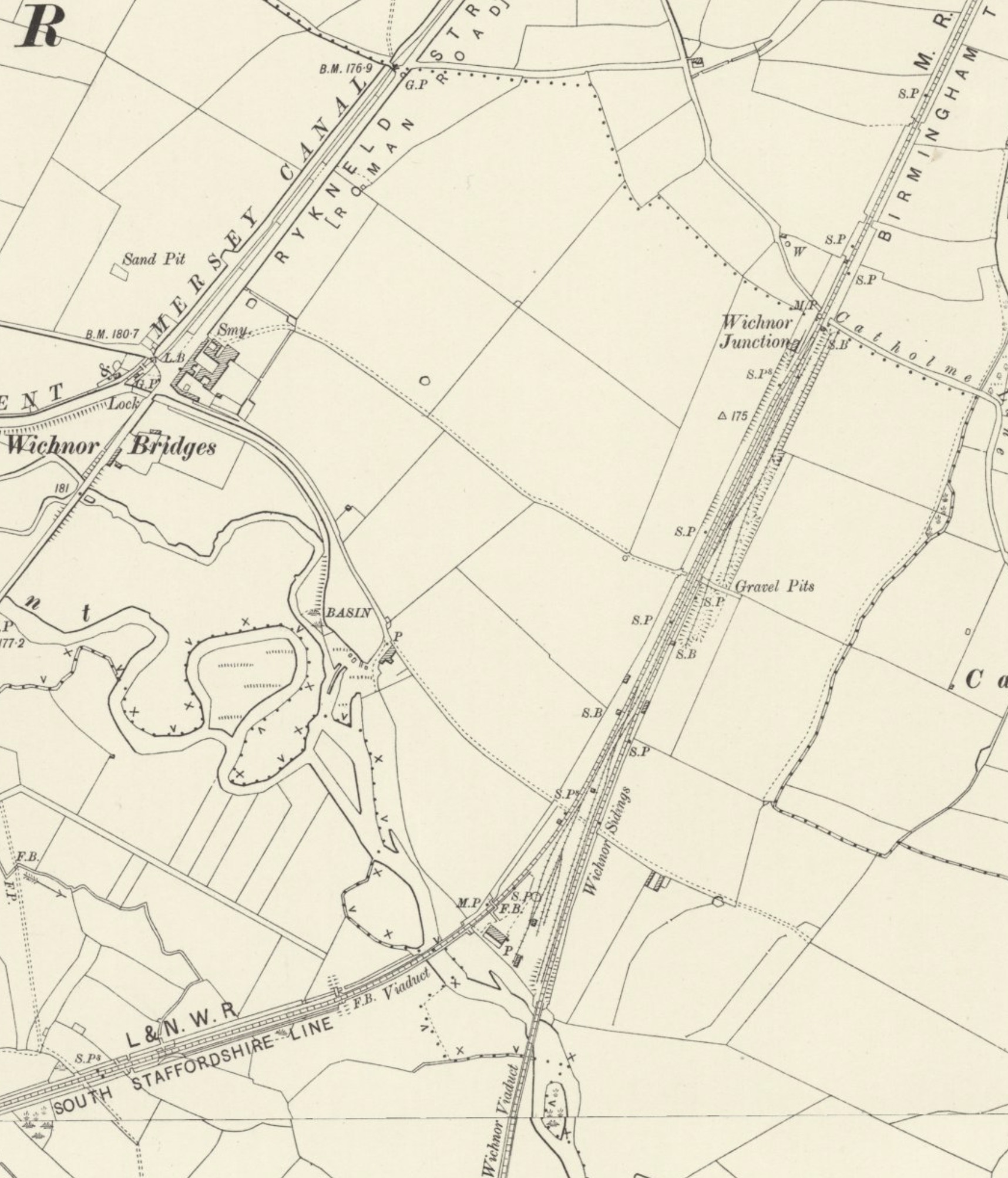
Courtesy of the National Library of Scotland (Creative Commons Licence)
(Right click and view in a new window to see this map full size or use the above link to view it interactively)
DERBY AREA SIGNALLING
Focus on
Wichnor Junction
This article is one of a series of studies of the signalling at locations within the Derby area. The objective of the work is to concentrate on the equipment, the men and the work done in the boxes, whilst giving an idea of the context of the surrounding railway.
Wychnor is a tiny hamlet which lies to the north of, and on the opposite bank of the River Trent to, the not much larger settlement of Alrewas in Staffordshire. Though Ordnance Survey maps over the years have flip-flopped over the spelling of Wychnor or Wichnor, the railway has remained consistent, and as such, it is Wichnor from here on...

The railway at Wichnor arrived with the opening of the Birmingham & Derby Junction Railway between Hampton and Arden and Derby on 5th August 1839. The line was amalgamated to become part of the Midland Railway on 10th May 1844. The South Staffordshire Railway opened their line from Walsall to passenger traffic on 9th April 1849. A deterioration in relations with the latter company in 1853 led to the Midland revoking the South Staffordshire's running powers over Midland metals, forcing a station to be built at Wichnor for the interchange of passengers and goods. The lease on the South Staffordshire Railway passed to the London & North Western Railway from early 1861.
The relationship between the Midland Railway and the London & North Western Railway is a complex and often an acrimonious subject and rarely more so than at Wichnor. Competitors in every sense, when the LNWR first attempted to reassert the running powers they nominally acquired from the South Staffordshire Railway and the resulting the stand-off became very physical. On 1st November 1861 the Midland, having learned of the LNWR's plans and determined to stop it, sent “a large contingent of men” to Wichnor. This resulted in the LNWR locomotive being chained to the rails! Commercial self-interest often forces cooperation on an operational level and so the LNWR running powers from here into Burton & Derby were restored a month after the stand-off. Though the passenger station was no longer required, the place remained a point of interchange for goods traffic for another hundred years or so.
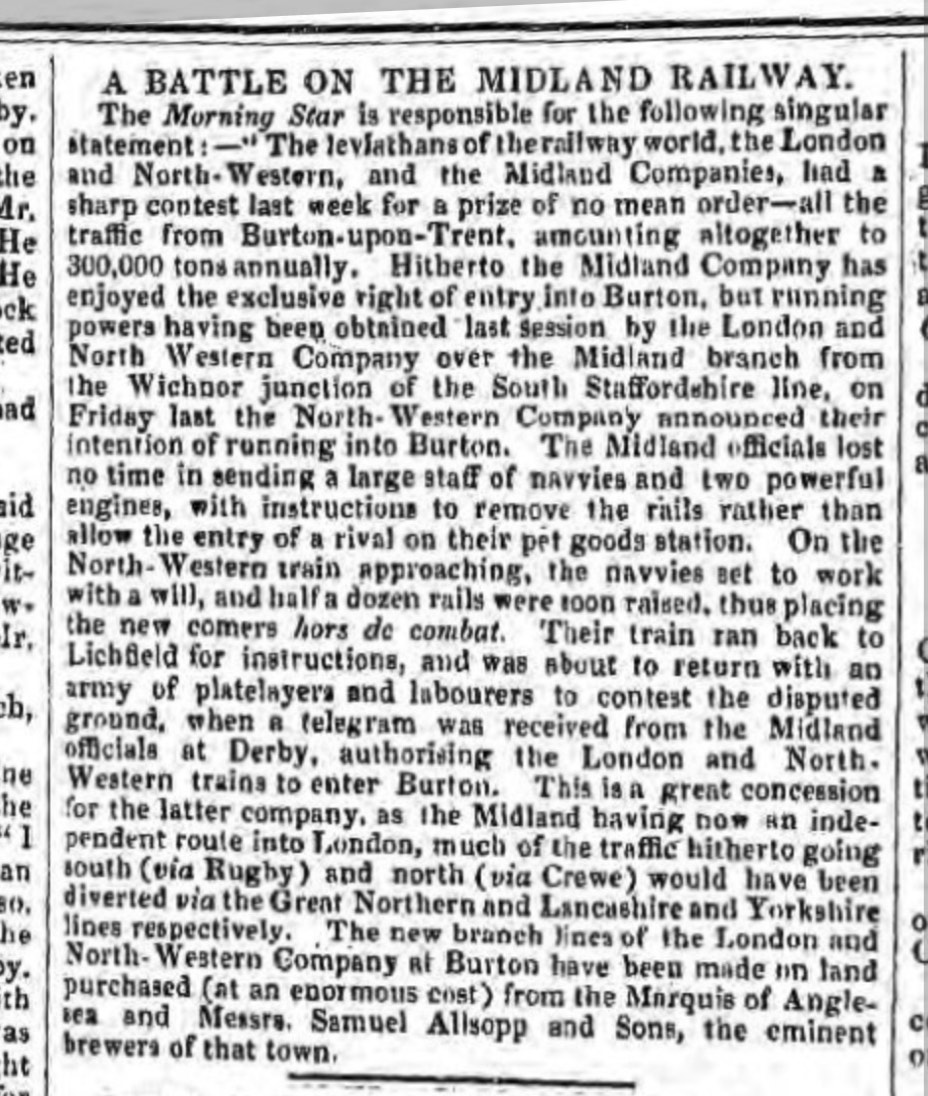
Whilst there would clearly have been a form of train control in the area from at least the creation of the junction, signal boxes as we would recognise them would have first appeared with the introduction of Block telegraph working. The Midland introduced block working between Leicester Junction (Burton) and Wichnor Junction on 18th March 1872, and onwards to Tamworth Curve Junction the following year. This period also saw the widespread adoption of interlocking frames to control points and signals thus preventing the pointsman from setting routes conflicting with his signals.
Around this time, signal boxes were being provided to house the locking frame and block telegraph instruments at most stations along the line, including Barton & Walton, Croxall & Haselour.
Wichnor Junction box was on the east of the Midland line, to the north of the junction, located16m 4ch from Derby. As the LNW lines diverged, the ground between the two company’s main lines was occupied by the “North End” sidings. Also located on the east side of the Midland lines, 26 chains to the south, that company provided Wichnor South Sidings signal box. This point also marked the location of the Goods Junction between the two companies. South of this point the two main lines went their own ways, the Midland toward the south-east and the LNW to the south-west. The “South End” sidings were provided in the ‘Y’ of formed by the goods Junction.
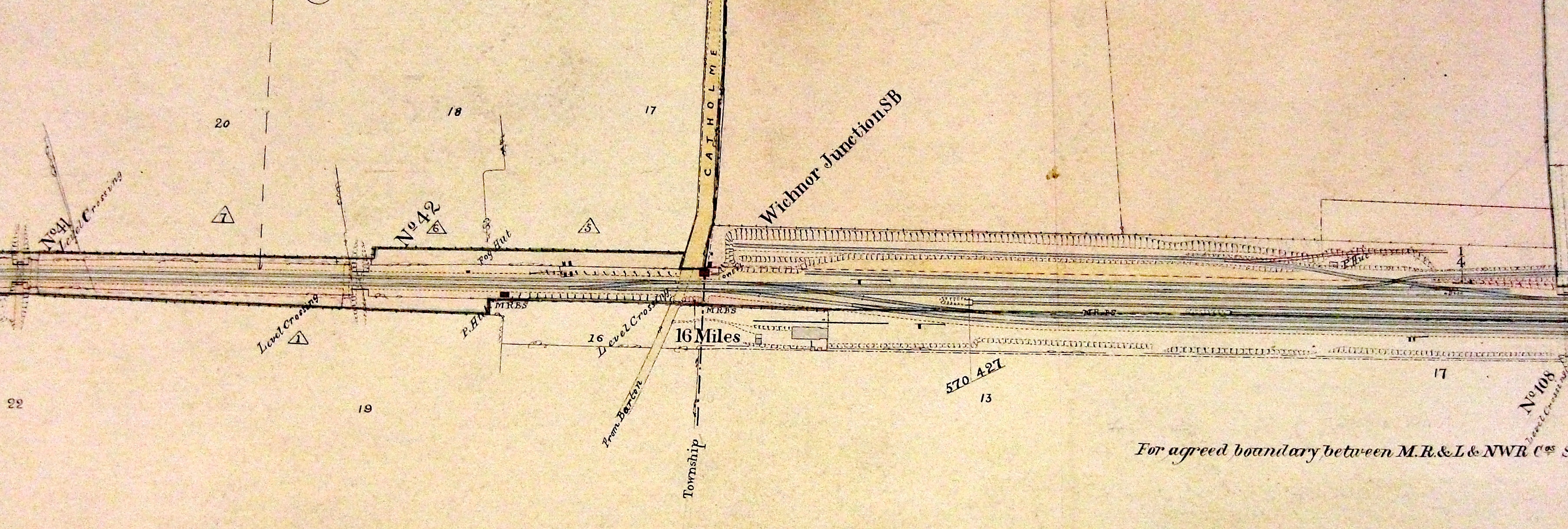
The third signal box at Wichnor Sidings was provided by the LNW on the west side of their lines, opposite the Midland’s Wichnor South Sidings box. In addition to the sidings, the LNW box controlled access to their small Loco shed.
By 1882, relations between the LNW & the Midland had thawed to such an extent that they were willing to co-operate with each other in areas of signalling efficiency. This resulted in the Junction box’s distant signal from the LNW lines, previously standing outside the LNW Wichnor Sidings box to be mounted on the same post as the LNW Sidings Down Home and Up Starter. (“Up” was away from Derby for the LNW and toward Derby for the Midland – as it remains today). To assist the signalman still further, in 1886 an indicator disc was fitted in the LNW box to enable the signalman to determine the position of the ‘slot’. It wasn’t until Sunday 5th July 1891 that the favour was returned. The Junction signals were all renewed with the old signals mounted on individual posts, as had been the common practice, being replaced by ‘bracket’ signals. With that renewal, the Midland’s Weekly Notice tells us that; “The distant signals fixed near Wichnor Junction, and worked from Wichnor Sidings and the L.&N.W. Co.'s Cabin, will be superseded by lower arms on the bracket posts of the Wichnor Junction down main line home signal”.
The development of Wichnor as a railway yard could not have been helped by the provision of a farmer’s occupation crossing right across the neck of the South End sidings. This extract from the Midland Company’s Notices dated 1896 gives some idea of the handicap the crossing created;
Stretton's Crossing, Wichnor; Should Stretton's Occupation Level Crossing over the Midland and L. & N. W. Railways at Wichnor require to be used during the time shunting operations are being performed, the Crossing must be cleared as quickly as possible, and the shunting operations discontinued until the lines have been crossed and when shunting is completed, care must be taken that vehicles are not left foul of the Crossing.
In the closing years of the 19th Century, as both traffic requirements and signalling standards were blossoming, the infrastructure of only a few years previously was rapidly reaching capacity and expansions were taking place. The summer of 1896 marks a time of significant reorganisation in the area. The original Wichnor Junction box of 1873 must have been well constructed because on 9th August 1896 it apparently received a new locking frame. (It is entirely possible a renewal in the interim has been missed from the historical record). Wichnor South Sidings box, which had been renewed on 23rd March 1884 was reframed on 23rd August 1896. Also that month, the LNW renewed its Wichnor Sidings signalbox. The new structure was 17' 6" closer to Alrewas and was18' 9" across the front by 12' wide. It was positioned 7’ from the nearest rail and the operating floor was 7' above rail height.
Croxall Station box, on the Midland line toward Tamworth was also reframed that summer, on 28th June 1896.
The last year of the Nineteenth Century saw two major renewals. On Sunday, September 24th 1899, (commencing at 6.0 a.m. to be precise) Wichnor Junction signal box was renewed, this box having a 20 lever frame. The other box to be replaced in 1899 was Alrewas Station signal box. The structure erected then survives today to the west of the line (i.e. the Down side) north of the level crossing. This was what has come to have been classified these days as a LNW Type 4 size G. All of which means that it has brick to floor construction with flat gable ends and finials. The front windows have 2+2+3+2 configuration hence the ‘Size G’ designation. This building was to see its 120th anniversary, still performing its intended purpose, … and counting.
The Twentieth Century began quietly as far as signalling developments in the Wichnor area were concerned. The box at Haselour station was renewed on 24th January 1904 and its neighbour at Croxall, 2m 1ch in the Derby direction, was also renewed two years later on 28th January 1906.
Some big changes were afoot, however, prompted by the inexorable rise in goods traffic. Sunday, October 27th 1907 saw the down lie-bye siding between Wichnor Junction and Wichnor South Sidings being extended at the back of the Wichnor Junction Signal Box, and brought into use as a down goods line. A new facing connection leading from the down main line to the down goods line, on the Burton side of Wichnor Junction Signal Box, was brought into use. The new down goods line was to be worked in accordance with the General Regulations for Train Signalling by Telegraph Bells.
Associated changes at Wichnor Junction included; the distant signals for the down main line was placed about 100 yards further from the Signal Box, the four-arm bracket signal for the down main line was superseded by a five-armed bracket signal about 100 yards further from the Signal Box, the upper and lower arms on the right-hand and middle posts applied to the same lines as the previous four-armed bracket signal, and the arm on the left-hand post was a home signal applicable to trains and engines going on to the new down goods line. A new ground disc signal to give permission for trains and engines to set back from the up main line, and a new ground disc signal to give permission for trains and engines to set back through the crossover road between up and down L. & N. W. lines, was brought into use.
The following year saw further expansion, this time at Haselour. On 26th April 1908 the Signal Box opened a mere four years previously was closed and a new Box opened. The connection between the down siding and the down main line was removed and dispensed with and the siding extended toward Tamworth and converted into a Down Goods Loop line. A facing connection leading from the Down Main Line into the new loop near the Tamworth end of the Station, and a connection leading from the Tamworth end of the loop line on to the Down Main Line were brought into use... The connection at the Tamworth end of the Station leading from the Up Main Line into the existing siding, the ground disc signals regulating the running of trains and engines from the existing siding on to the Up Main Line and Down Main Line and the ground disc signal giving permission for trains and engines to set back from the Down Main Line into the siding were removed and dispensed with. The following new signals were brought into use... A two-armed bracket directing signal for the Down Main Line at the new facing connection, the right-hand arm applying to trains and engines going forward on the Down Main Line and the left-hand arm to trains and engines going on to the Goods loop line, a two-armed bracket signal to regulate the running of trains and engines from the goods yard sidings, the right-hand arm to apply to trains and engines going on to the new Goods loop line and the left-hand arm to trains and engines going into the new siding. An advanced starting signal for the Down Main Line on the down side of the line. An instruction was issued that the distant signal for the Down Main Line was only to be lowered for trains and engines going forward on that line and not for trains and engines entering the Goods loop line.
At the Tamworth end of the Down Goods Loop line the connection between the end of that line and the Down Main Line was worked by Guards and Shunters from a stage bolt-locked from the Signal Box. The connection between the new siding and the new goods loop line and the following new signals were worked by Guards and Shunters from the stage... A single-armed signal between the Down Goods loop line and the siding to regulate the running of trains and engines from the loop line, and a ground disc signal outside the new siding to regulate the running of trains and engines from the siding on to the Down Main Line. Curiously, having already been renewed in 1904 and 1908, Haselour station box was again renewed on 5th November 1911. Renaming of the station to Elford took place on 5th May 1914 and the box was similarly renamed at some subsequent time.
The onset of The Great War not only put a stop to any further expansion but, arguably, marked the beginning of the contraction which has occurred ever since. Neither the London & North Western nor the Midland Railway had cause or opportunity to make any changes to the signalling of the Wichnor area before they were ‘grouped’ as constituents of the London, Midland & Scottish Railway.
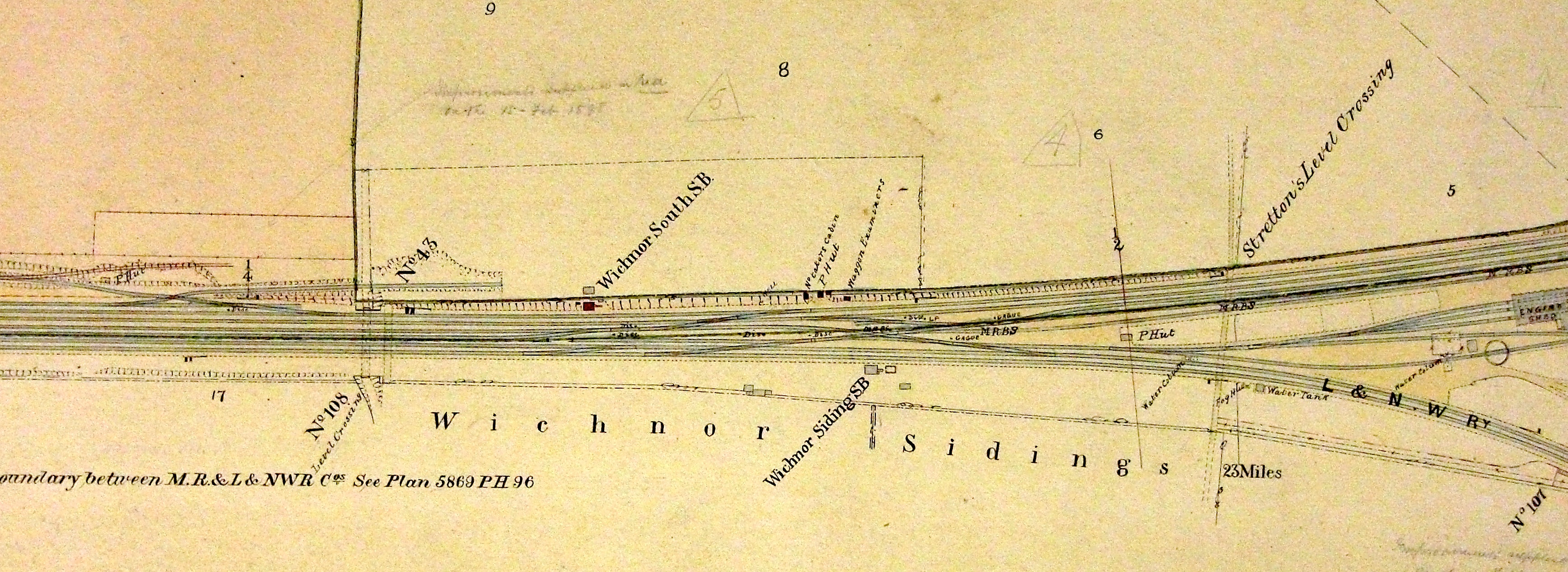
Desperate to cut costs, the LMS quickly looked very carefully for savings. Installations such as Wichnor which owed their existence exclusively to the fact that they were inter-company exchange sidings were of course rife with duplicated facilities. Sure enough, as early as 1st March 1923 the LMS Traffic Committee considered the situation at Wichnor;
The General Manager reported that the retention of the three signal boxes at Wichnor, namely:-
Wichnor Junction - controlling the Junction of the Lichfield line with the Derby and Birmingham line.
Wichnor South Sidings - controlling the connections in the Derby and Birmingham line.
Wichnor Sidings - controlling the connections in the Lichfield line.
which were within a very short distance of each other could not under the present circumstances be justified and he recommended that one signal box be provided to take the places of the existing Wichnor South Sidings and Wichnor Sidings signal boxes, as shewn on plan submitted, at an estimated cost, including the provision of four additional ground signals to modernise the signalling, of £2,321. The Wichnor South Sidings signal box required renewing immediately and the cost of such a renewal would be £1,031 so that the expenditure involved in amalgamating the signal boxes would be £1,290, and whilst the cost of maintenance would remain approximately the same, there would be a saving in signalmen's wages of £441 per annum.
He stated that if the Up Home and Distant signals for the Birmingham and Derby line were controlled from the Wichnor Junction signal box the traffic could be worked satisfactorily without the Wichnor Sidings box being opened on Sunday and Sunday nights as was the case at present, and he recommended that the alteration be carried out at an estimated cost of £160, which would result in a further saving in signalmen's wages of £143 per annum.
Whereas the Midland’s Wichnor South Sidings and the LNW’s Wichnor Sidings boxes faced one another on either sides of their respective main lines, the new Wichnor Sidings box was located in the ‘Y’ of the Goods Junction. Space being at a premium at this point the box was cantilevered on both sides; i.e. the 20’x10’ box was on a 20’ x 5’ base. The box was formed of two 10' flakes with two flights of steps at the south end and the frame at west side. In the modern categorisation of signal boxes, the basic design of this box is referred to as a Midland Type 4d.
Another method favoured by the LMS of cutting signalling costs was the Intermediate Block Section. Where a signal box existed simply to shorten the block section and thus increase capacity of the line, the development of track circuit technology had, by the 1930’s allowed this function to be performed remotely. As the station it served had closed some five years previously, on 27th August 1933 the signal box at Croxall was abolished and ‘approach lit’ I.B.S. signals provided in lieu. The signal on the Down line were controlled by Wichnor Sidings whereas on the Up it was controlled by Elford. Elford had already had an I.B.S. signal on the Down line from 26th February 1933 when Wigginton signal box was thus replaced.
In periods of depression, when railway work was sought after, finding staff to work at Wichnor may not have been difficult. The National Union of Railwaymen produced a list of seniority in 1930 which allows us to know who it was that was working in the boxes in the area at that time. It also provides information concerning the classification of the boxes and some idea of the service these men had given the railway.
For example, at that time Wichnor Junction – a Class 3 box – was worked by Messrs. E.Jones, A.G.Hitchings and E.S.Sheppard. These men had been signalmen since 27th September 1891, 12th January 1897 & 14th April1902 respectively. Meanwhile, at Wichnor Sidings – also a Class 3 – there were Messrs. A.Noon, J.T.Hewitt and F.W.Harcombe. This box had been regraded on 8th December 1923 to reflect the work of the new box. These men also had between 20 & 30 years experience as signalmen. At the other end of the scale, of the three men at Croxall – still a main line box as reflected by its Class 4 grade – Messrs. W.F.Webb, H.Webb & H.Pegg, the latter had become a signalman as recently as 18th August 1921.
Following the initial cuts by the LMS, the railways of Wichnor had entered a lengthy period of stability. The outbreak of the Second World War had a huge impact on the railways generally, but at Wichnor, the existing facilities coped. Other than the provision of an air-raid shelter adjacent to the Wichnor Sidings box and building of pill-boxes near the river crossing, many of which remain to this day, little change occurred at Wichnor.

The Midland Railway signal boxes of the Nineteenth Century were constructed by fixing their main upright timbers to a crossbeam buried in the ground. This method of building was fine for the Midland as they were replacing their signal boxes regularly, rarely allowing a box to remain more than twenty years. Later methods of building employed concrete foundations, being much less prone to rot. However, the legacy of the downturn in the railway’s fortunes in the Twentieth Century was that this expansion driven programme of replacement was drastically curtailed. As a result following the Second World War, in addition to the an immense task facing the railways bringing the infrastructure back up to standard, many of the older Midland Railway signal boxes were in dire need of replacement.
One such box was Wichnor Junction which, by 9th August 1953, was over 50 years old. Its replacement was a great leap in signal box design, the then ‘standard’ design, now designated Type 14. Whilst following the same rough pattern – substantial buildings of red brick construction with metal window frames and a flat concrete roof, two flights of concrete steps leading up to extension on the end which accommodated a toilet – each Type 14 box was individually designed by an architect. This added to an already substantial building cost. This box was provided with a 25 lever 4½” Standard frame installed in the rear of the box.

The 1960s dawned on a note of optimism. A pan dated June 1960 was produced by British Rails' Chief Civil Engineers Department in which it was proposed that the electrification of the West Coast Main Line would include the South Staffordshire Line. On that basis, Wichnor would be reinvigorated as it would be the point at which electric and diesel locomotives were swapped for one another. Some rationalisation was called for – notably, Wichnor Sidings signal box would take over control of the junction, allowing (the newly rebuilt!) Wichnor Junction box to be abolished.
Clearly it was not to be. The South Staffordshire remains un-electrified and the unprecedented decline of the 1960’s inexorably began to bite. The South Staffordshire line, which had sustained a Burton to Walsall passenger service thanks to the introduction of Diesel Multiple Units, closed to passengers with effect from 18th January 1965. The run-down of the sidings at Wichnor was such that Wichnor Sidings signal box could be abolished on Sunday, 26th May 1968. As well as detailing the abolition, the following Notice gives some indication of some of the minor changes which had taken place thus far;
Between Wichnor Jn. and Elford and Alrewas Stations: - Wichnor Sidings signal box will be closed and all signal arms worked therefrom, with the exception of those shown below, will be taken away. The new block sections will be:-
Main Lines. Elford – Wichnor Jn.
Western Lines. Alrewas Station – Wichnor Jn.
Wichnor Jn.: The down main I.B. home and distant signals, formerly controlled by Wichnor Sidings box, will be controlled from this box. The I.B. home signal will be 3,336 yards from, and the telephone at this signal connected through to, this box. The up main line home signal will be redesignated up main line inner home signal and an up main line outer home signal, situated 546 yards on the Birmingham side of the box and 16 feet above rail level, will be provided. A telephone will be provided at this signal. The up main line inner distant signal will be taken away. The up main line outer distant colour light signal, which was also Wichnor Sidings box up main line distant signal, will be redesignated up main line distant signal and the double yellow aspect extinguished. This signal will be 1,536 yards from the home signal to which it applies. The former Wichnor Sidings up Western line home signal will become the up Western line starting signal for this box 600 yards on the Lichfield side of this box. A <> sign will be fitted to the post of this signal. The down Western line home signal will be redesignated down Western line inner home signal and an outer home signal situated 546 yards on the Lichfield side of the box and 20 feet above rail level will be provided. A <> sign will be fitted to the post of this signal. The down Western line inner and outer distant signals will be taken away and the former Wichnor Sidings box down Western line distant signal will become the down Western line distant signal for this box, 1,210 yards from the home signal to which it applies.
The changes of 1968 were simply a small taste what was to come the following year. Power signalling had been the aim of British Rail for some time. As early as 1962 the “Midland Line Plan” proposed a series of power boxes and Wichnor would have been controlled from a PSB located at Burton. As technology (and confidence in remote interlockings controlled controlled electronically from many miles away increased) the plans became more wide-ranging. In the end, the Wichnor area was to be in the first stage of implementing Derby Power Box. In order for the power box, over 16 miles away, to control the junction, the opportunity was taken to use the land released by closing the siding to simplify the junction. As the former passenger junction was 16 chains further north than the point that the routes actually diverges, it was decided to site the new junction 560 yards further south. On 13th April 1969 a new facing junction was laid-in at the site of Wichnor Sidings. The following Sunday a trailing crossover on the Walton side of the new junction was laid-in.
The change-over from semaphore to power signalling took place over the weekend of Saturday 14th to Monday 16th June 1969 with the new junction being commissioned on the Sunday. At the same time, Elford box was closed and the Down Goods loop it controlled taken over by Derby panel. The Up line at the former junction was plain lined on 22nd June 1969 and the Down line similarly treated on 6th July 1968. Alrewas remained as a fringe box to Derby. Its function as a crossing box, supervising what was still the busy A513, assuring its future. By then the level crossing gates which had been operated by a gate wheel had been replaced by full skirted lifting barriers.
Wichnor Junction signal box was not to disappear without one last moment of drama. On 15th February 1969 a tractor driver drove his muck spreader onto the occupation crossing located 40 yards on the Derby side of Wichnor Junction box. A coal train had just passed on the Down line and the tractor driver thought he was clear to cross. The vigorous waves of the signalman were, he thought, all the confirmation he needed. In fact, the 13:00 Birmingham to Derby DMU was approaching at 60mph under clear signals, but masked from the tractor driver by Wichnor Junction box itself. As fate would have it, all the 20 passengers on board were in the rear coach of the three car unit, leaving just the unfortunate Driver J.R.Dyer of Derby to take the full force of the impact. He was found unconscious in the wreckage, lying on the ceiling of the first class compartment of the leading vehicle. He was critically injured and was cared-for by a nurse who had fortuitously been a passenger on the train. Fortunately, Driver Dyer survived his ordeal. The tractor driver later reported he had “felt a slight bump”.
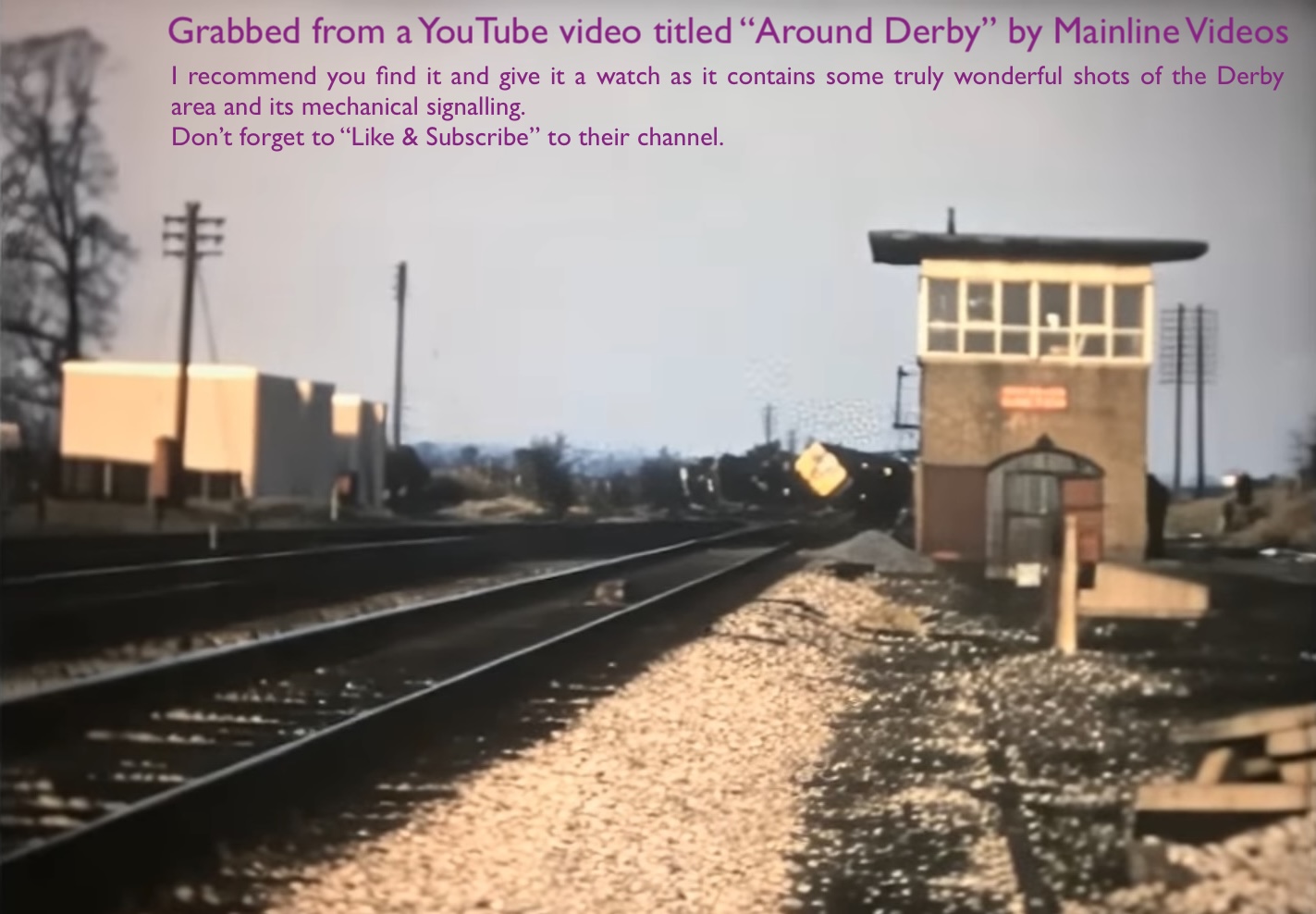
With Alrewas box remaining the sole survivor of the mechanical signalling age, what remains is mostly a postscript. The occupation crossing which had been the scene of the near-tragedy has been replaced with a bridge. The other occupation crossing a little further south which so inconvenienced shunting in the North Sidings was also closed.
In 2001 a fleet of next generation Diesel Multiple Units, known as Voyagers by their owners when new, were introduced into service. To facilitate their maintenance a completely new Traction Maintenance Depot known as Central Rivers was constructed on the west side of the line, just to the north of Wichnor Junction. To allow trains access to and from the deport via the South Staffordshire Line (and thence the West Coast Mainline at Lichfield Trent Valley Junction), bi-directional signalling has been was installed on Up line.
Dave Harris, Willington, Derby, UK.
Email: dave@derby-signalling.org.uk
Page last updated: Monday, 13 November 2023